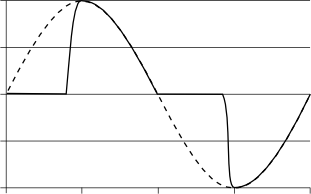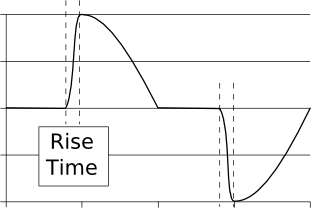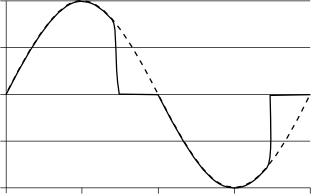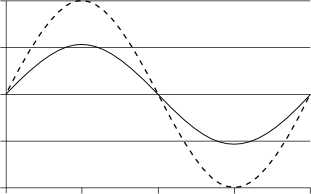Dimming Information
Dimming is the process of controlling the amount of electrical power to a light source. (typically a tungsten lamp, although other loads like fluorescent lamps or LEDs may be dimmed as well.) There are three methods of dimming in common use; Forward-Phase, Reverse-Phase and Sinewave dimming. Each has advantages and disadvantages as discussed below.
Forward Phase Dimming
 Also commonly known as "Triac Dimming", "SCR Dimming" and phase control dimming, Forward Phase dimming control is the most common form of dimming. It uses a silicon device, usually an SCR or a Triac, to turn the mains waveform on part way through its cycle.
Also commonly known as "Triac Dimming", "SCR Dimming" and phase control dimming, Forward Phase dimming control is the most common form of dimming. It uses a silicon device, usually an SCR or a Triac, to turn the mains waveform on part way through its cycle.
By varying the point at which the waveform turns on, we can alter the amount of power delivered to the lamp.
There are many advantages to forward phase dimming, making it the most commonly used of dimming technologies. Primarily it is cheap, reliable, and well proven having basically worked in the same manner since the mid 1970s.
Forward Phase dimming is used in ETC's SCR dimmers like Sensor dimmer modules (e.g. D20, ED15), Matrix SCR dimmers, Smartpack and Smartbar.
Disadvantages of forward phase dimming include audible noise, electrical noise (harmonics) and inefficiency.
Noise in Forward Phase Dimming
 The most noticeable source of noise in a forward phase dimming system is the filaments of the lamps being dimmed. When the power is turned on to the lamp part way through the mains cycle, the filament expands very rapidly, and then as the voltage ramps back down again the filament cools. This rapid cycle of expansion and contraction leads to "Lamp Sing".
The most noticeable source of noise in a forward phase dimming system is the filaments of the lamps being dimmed. When the power is turned on to the lamp part way through the mains cycle, the filament expands very rapidly, and then as the voltage ramps back down again the filament cools. This rapid cycle of expansion and contraction leads to "Lamp Sing".
This can be abated in SCR and Triac dimming systems by the use of chokes in series with the lamp. This is why all modern dimmer modules have chokes fitted to them. The choke has the effect of reducing the rate at which the current through the lamp increases when the voltage is reapplied. The effectiveness with which the choke does this is measured as the rise time of the dimmer. Rise time is measured in microseconds (us) and is one of the factors in how much noise a lamp connected to a dimmer will make. It is important to remember it is not the only factor, other factors include cabling, input power frequency and the size and shape of the lamp filament being dimmed.
Reverse Phase Dimming
 Reverse phase dimming takes the opposite approach to forward phase dimming and switches the sinewave off part way through the cycle. Some architectural loads perform better this way, such as some fluorescent ballasts or electronic transformers. It is very important when dimming a non-tungsten load to determine whether forward or reverse phase dimming is appropriate. Usually this information will be listed in the manufacturers datasheet.
Reverse phase dimming takes the opposite approach to forward phase dimming and switches the sinewave off part way through the cycle. Some architectural loads perform better this way, such as some fluorescent ballasts or electronic transformers. It is very important when dimming a non-tungsten load to determine whether forward or reverse phase dimming is appropriate. Usually this information will be listed in the manufacturers datasheet.
Sinewave Dimming
 Sinewave dimming acts in a similar way to running a load via a variable transformer; a true variable voltage is supplied to the load. Sinewave dimming has many benefits including very low or silent lamp noise and lower power consumption, but is more expensive to install initially. Sinewave dimming is available in the Matrix and Sensor product lines from ETC.
Sinewave dimming acts in a similar way to running a load via a variable transformer; a true variable voltage is supplied to the load. Sinewave dimming has many benefits including very low or silent lamp noise and lower power consumption, but is more expensive to install initially. Sinewave dimming is available in the Matrix and Sensor product lines from ETC.
A notable disadvantage of Sinewave dimmers is that they don't interact well with LED loads - it's likely that sinewave dimmed LEDs won't dim at all. This is because line voltage dimming LEDs react to the hard phase angle that's present in both forward and reverse phase dimming, which Sinewave dimmers were designed to eliminate.
